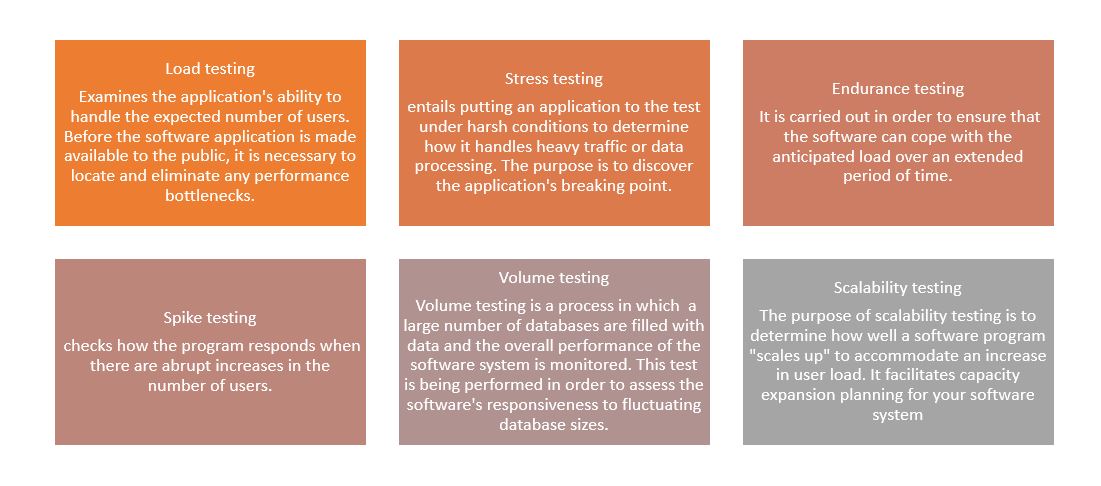 January 20, 2022
January 20, 2022
In this blog, we’ll cover…
Why To Do Performance Testing?
Difference Between Performance Testing And Load Testing
Load testing and performance testing are frequently used interchangeably by software testers. There is a significant difference between the two processes, however, as each evaluates the performance levels of different system components.
Load and performance testing is essential for any software tester who wants to be successful. Accuracy in identifying underlying vulnerabilities is critical to the quality of any software system that uses these testing methods.
A lack of understanding of the differences between these processes can lead to ineffective application in specific development environments. In the following section, we’ll explain the differences between load testing and performance testing.
What is performance testing?
Performance testing is a method of software testing that is utilized to analyze the speed, reaction time, stability, reliability, scalability, and resource consumption of a software program when it is being subjected to a particular load. The fundamental purpose of performance testing is to identify and get rid of performance issues in software applications. Performance testing is a subset of performance engineering that is most generally referred to by its acronym, “Perf Testing.”
Why to do performance testing?
Testing the application’s performance is done so that stakeholders can get an idea of the application’s performance as well as its stability and scalability. Testing the product’s performance is essential for figuring out what aspects of the design need to be modified before it can be sold.
When performance testing is not done, a number of problems can occur, some of which are a sluggish experience when using the software simultaneously with other people, differences in operating systems, and poor usability.
Their software is going to be evaluated to determine whether or not it has the capacity to deal with the anticipated workloads in terms of speed, scale, and stability. Products that are brought to market with inadequate performance metrics are more likely to receive a negative reputation and to fall short of sales targets if there was insufficient or no performance testing done on the products.
Types of performance testing
Load testing:- Examines the application’s ability to handle the expected number of users. Before the software application is made available to the public, it is necessary to locate and eliminate any performance bottlenecks.
Stress testing:- entails putting an application to the test under harsh conditions to determine how it handles heavy traffic or data processing. The purpose is to discover the application’s breaking point.
Endurance testing:- is carried out in order to ensure that the software can cope with the anticipated load over an extended period of time.
Spike testing:- checks how the programe responds when there are abrupt increases in the number of users.
Volume testing:- Volume testing is a process in which a large number of databases are filled with data and the overall performance of the software system is monitored. This test is being performed in order to assess the software’s responsiveness to fluctuating database sizes.
Scalability testing:- The purpose of scalability testing is to determine how well a software program “scales up” to accommodate an increase in user load. It facilitates capacity expansion planning for your software system
What is Load testing?
The performance of an application is evaluated during a load test, which is a type of non-functional software testing technique. The load test is designed to simulate actual user activity. It has an effect on how a software application behaves while being used by multiple users at the same time. Load testing is performed in advance of deployment with the intention of removing performance bottlenecks and ensuring that software programs are stable and functional.
It is related to testing that is not functional. In the field of software engineering, load testing is put to great use for both client-server and web-based applications, on both the intranet and the internet.
Why to do Load testing?
Load Testing ensures that the performance of your application in production is in line with your expectations. Even if your application passes a functional test, this does not guarantee that it will perform similarly under stress. Through load testing, it is possible to find out where and when your application fails, allowing you to fix the problem prior to releasing the software for general use.
Businesses and consumers rely heavily on digital apps, so it is critical to ensure that they can withstand real-world load scenarios. Higher quality standards have come along with the rise of digital apps, and if your app fails in production, it can be costly.
Tools like load testers are designed to reduce risk, whether it’s a threat to your software’s functionality, the sanity of your customers, or even a potential financial loss. All three are intertwined, so it’s important to know where you, as a developer ortester, can make a difference for the greater good and how to do so. There are a lot of load-testing issues that actually boil down to the perception of users rather than to specific ideal page load times and other technical statistics, if you focus on reducing user sanity.
Difference between Performance testing and Load testing
Wrapping it up
Finally, load testing is a subset of performance testing that focuses on performance issues that arise when the number of users increases. Testers are better equipped to identify the overall system performance issues when focusing on performance rather than functionality.
Performance testing is essential for spotting flaws in your system at its most fundamental level. Request that a team of QA experts identify and eliminate all of your product’s underlying weaknesses so that it is well-protected against downtimes and crashes caused by variable user load.
Software application quality assurance is a specialty of Performance Lab, which serves a wide range of industries. In the course of their career, they’ve had the opportunity to test a wide range of products. For thorough product performance testing, get in touch with Performance Lab right away.






